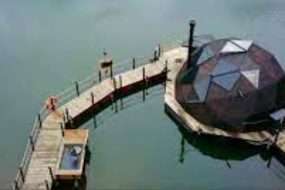
In the fast-paced world of transportation, where speed, efficiency, and sustainability are paramount, the Hyperloop is nothing short of a technological marvel. This visionary concept, first introduced by Elon Musk in 2013, has the potential to revolutionize the way we travel. But what lies beyond the Hyperloop? In this in-depth exploration, we will delve into the intricacies of this cutting-edge transportation system and its potential impact on the future of travel and beyond.
The Hyperloop Unveiled
The Hyperloop is a high-speed ground transportation system that utilizes a network of low-pressure tubes to propel passenger pods at incredible speeds. It's like something out of a sci-fi movie, but it's very real. This technology has the potential to redefine the way we think about long-distance travel, making it faster, more efficient, and eco-friendly.
How It Works
At the core of the Hyperloop is the concept of reduced air pressure in the tubes, minimizing air resistance and allowing the passenger pods to travel at near-supersonic speeds. Magnetic levitation and a linear electric motor are used to propel and guide the pods through the vacuum-like environment, ensuring a smooth and ultra-fast journey.
Environmental Sustainability
One of the most exciting aspects of the Hyperloop is its potential to be an eco-friendly mode of transportation. With zero direct emissions and the ability to harness renewable energy sources, the Hyperloop could help reduce our carbon footprint significantly.
Current Developments
Several companies, including Virgin Hyperloop and SpaceX, are actively working on developing the technology further. Test tracks and prototypes have been in the works, and it's only a matter of time before we see the Hyperloop become a reality.
Hyperloop vs. Traditional Transportation
Speed and Efficiency
Compared to traditional trains, the Hyperloop offers unparalleled speed and efficiency. While high-speed trains can reach impressive speeds, the Hyperloop can potentially travel at speeds of up to 760 miles per hour, cutting travel times significantly.
Infrastructure and Cost
The Hyperloop's infrastructure is designed to be less intrusive and more cost-effective than high-speed rail systems. With smaller support columns and reduced land usage, it promises to be a more feasible option for urban environments.
Safety
The Hyperloop's enclosed system minimizes the risk of accidents and derailments, providing a higher level of safety compared to traditional trains. Passengers can enjoy a worry-free journey.
Beyond the Hyperloop: Future Innovations
While the Hyperloop is a game-changer in transportation, it's not the only innovative concept in the works. The transportation industry is constantly evolving, and there are other exciting developments on the horizon.
Maglev Trains
Magnetic levitation (maglev) trains have been in development for decades and are gaining popularity. These trains use magnetic fields to levitate and move above the track, reducing friction and increasing speed.
Autonomous Vehicles
Self-driving cars and autonomous public transportation are becoming more prevalent. These innovations have the potential to make travel safer and more efficient, with reduced traffic congestion.
Supersonic Travel
Companies like SpaceX and Boom Supersonic are exploring supersonic air travel, which could drastically reduce long-haul flight times and make international travel even more accessible.
Final Words
In the ever-evolving landscape of transportation, the Hyperloop stands as a beacon of innovation, promising to reshape how we move from place to place. As we look beyond the Hyperloop, it's evident that the future holds even more exciting possibilities. From maglev trains to autonomous vehicles and supersonic travel, the next era of transportation is sure to be a thrilling ride.
Commonly Asked Questions
1. What is the Hyperloop's potential impact on the environment?
The Hyperloop has the potential to be a game-changer in environmental sustainability. With zero direct emissions and the ability to harness renewable energy sources, it could significantly reduce our carbon footprint.
2. How does the Hyperloop compare to traditional high-speed trains in terms of speed?
The Hyperloop is a step ahead when it comes to speed. While high-speed trains are fast, the Hyperloop can potentially travel at speeds of up to 760 miles per hour, drastically cutting travel times.
3. Are there any safety concerns with the Hyperloop?
The enclosed system of the Hyperloop minimizes the risk of accidents and derailments, making it a safer mode of transportation compared to traditional trains.
4. What are some other innovative transportation technologies to look out for?
In addition to the Hyperloop, keep an eye on maglev trains, autonomous vehicles, and supersonic air travel, as they all have the potential to revolutionize the way we move from place to place.
5. When can we expect the Hyperloop to become a reality for everyday travel?
Several companies are actively working on developing the technology, and test tracks and prototypes are already in progress. While it's difficult to pinpoint an exact timeline, the Hyperloop is inching closer to becoming a reality for everyday travel.











